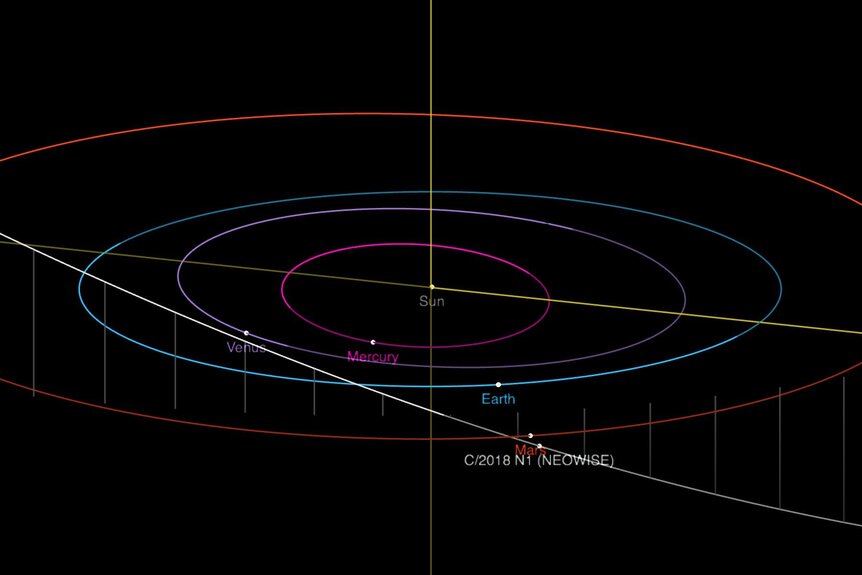Create a free profile to get unlimited access to exclusive videos, sweepstakes, and more!
TESS watches a comet (and variable stars and Mars and a bunch of asteroids) go by

NASA's Transiting Exoplanet Survey Satellite — TESS — has begun scientific operations. That means it is now sweeping the sky, looking at millions and millions of stars, searching for telltale dips in light that indicate planets are orbiting those stars.
You can read up on how it will do that in an earlier article I wrote, and even get a taste for what it will see in an article about First Light, when it first opened its metaphorical eye to the heavens.
On July 25, before science observations had begun and TESS was still taking images for calibration and testing, it took a series of observations over the course of 17 hours that prove to be pretty dang cool. TESS points in the direction more-or-less opposite the Sun in the sky, and on that date it just so happened that a faint comet, C/2018 N1 (NEOWISE) was passing through that region. Well, faint to those of us on Earth, but TESS has pretty sensitive cameras on board, and so the comet looks rather bright.
NASA made a video of the observations. Watch!
There is so much cool stuff going on there! Let me give you some particulars.
When these images were taken the comet was about 47 million kilometers from Earth. It orbits the Sun on a highly elliptical path, taking it just inside the orbit of Mars to about 200 billion km from the Sun — 40 times farther away than Neptune! That's based on early observations, so the uncertainty in the size of its orbit as large. Take those numbers with a Ceres-sized grain of salt.
It's about as close to the Sun as it gets right now, so it's moving at quite a clip. You can see its motion obviously in the video. It has a noticeable tail, which is gas and dust blown away from the comet's solid nucleus by the solar wind. This tail points away from the Sun — some people think the tail trails behind the comet in its orbit but there's no friction in space to let it blow behind. Instead the high-speed solar wind slams into the particles and sends them moving more-or-less directly away from the Sun.
Remember we're looking opposite the Sun in the sky here toward the comet. The tail is pointing in the same direction all the time, but as the comets moves perpendicular to the direction we're looking we see a slightly different perspective on the tail, so the angle appears to change as it moves. Pretty nifty.
But there's more! As it happens, Mars is in roughly the same direction as the comet as seen from Earth (though it's about 11 million kilometers farther away). It's not in the field of view, but it's so bright that we see stray light from it, light that gets bounced around from the side into the cameras' apertures. The video points out the faint Martian fan of light, too.
You can see stars in the video, too, but they look funny. Some appear to be both bright and dark, while others go from bright to dark! What's that all about?
This is due to the way the images were processed to make the video. I'm pretty sure what happened is that someone took all the frames making up the video, aligned them as best they could (so that, say, a given star in every image fell on the same pixel), and then took a median frame and subtracted it from each individual frame.
Taking a median is the mathematical process where you take a series of numbers and find the value where half the values are above that number and half below. So, say, in the series [1, 1, 3, 3, 4, 5, 6, 7, 8], the median is 4 ([1, 1, 3, 3] are less than that value and [5, 6, 7, 8] are greater). Note that this is different than the average, which for this series would be 4.2.
A median frame is where you do this for a series of images, and get the median value for every pixel in those images. The result is an image where every pixel is assigned the median value for that pixel. The advantage of this is that if you have the comet moving, it's in a given spot for one frame, then a different spot the next. In a median frame, all the highest value pixels (where things are brightest) are thrown out, and for a given pixel that'll be the ones where the comet is. When you create the median frame, it's as if you erased the comet!
If a star has a constant brightness, the median frame will just have that value for the pixel containing the star. So it doesn't appear to change (unless you don't have the star perfectly aligned, in which case sometimes when you subtract the median frame from an individual one you get too big or too small a value, which is why some stars look both dark and bright).
If a star is a variable star, changing its brightness, then after you subtract the median frame, the star will have a positive value (so looks white) when it's bright, and a negative one when it's fainter (and look dark). You can spot several such stars in the video.
Finally, there are also quite a few asteroids moving in the images. TESS was looking pretty much right into the plane of our flat solar system, and so it is looking right through the main asteroid belt. That's why there are so many! They're highlighted at the end of the video. It might help to run it at half speed to see them better.
Mind you, all this was seen in 17 hours of data taking. TESS will be operational for a base mission of two years, looking over the entire sky for exoplanets orbiting nearby stars.
Two years. What will we find in this data? Oh, I can't wait to find out.



























